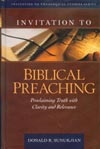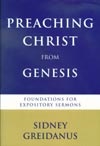Skill Builders
Article
2007 Preaching Book Awards
Effective preachers are always growing, and those who grow read.
Each year, PreachingToday.com selects two new preaching books for book-of-the-year awards: one that focuses primarily on the skills of preaching and the other on the soul of the preacher. Both are essential.
The winners this year were chosen by votes from two preaching experts and Brian Larson, the editor of PreachingToday.com. In this article we honor the book published in 2007 that wins the preaching skills award.
2007 Book of the Year for Preaching Skills
Invitation to Biblical Preaching
Proclaiming the truth with clarity and relevance
by Donald R. Sunukjian
Kregel, 2007
 |
If you find lacking the three traditional categories of preaching—topical, textual, or expository—you are in for an invigorating read in Donald Sunukjian's book Invitation to Biblical Preaching. Don, a former pastor and now teacher of preaching, writes, "Today we define true biblical preaching by how the biblical material is treated—that is, faithful to the meaning and flow of the original author and relevant to the contemporary listener."
For example, you may be surprised to read an author who is passionate about using Scripture properly say that the favorite whipping boy of "expository preachers"—topical sermons—can be thoroughly biblical and truly expository.
Don says biblical preaching requires two things. First we present the true and exact meaning of the biblical text. Second, we do so in a manner that is clear, believable, and relevant to the contemporary listeners.
Lots of books tell you to be clear; Biblical Preaching goes into thorough detail about how to be clear.
If you have ever scratched your head and wondered how to develop an outline, this is the book for you. Think through what Don asks you to think through, and you will never lack for ways to develop an idea.
If you ever have trouble coming up with content for a sermon, this book is for you.
If you ever wonder whether your preaching is truly biblical, this book is for you.
The book breaks down into two parts: (1) Look at what God is saying; and (2) Look at what God is saying … to us!
If sermon logic and clarity is ever a problem for you, Don can help you. Yes, we are supposedly in the nonlinear postmodern age, but though linear logic may not be as obvious in messages today, there still must be a logic of some sort and transitions or no one can understand the thoughts of the speaker.
Here are some additional thoughts on Sunukjian's work from our two judges:
I chose Sunukjian's Invitation to Biblical Preaching because of its scope. This book will help the beginner understand the foundations of biblical exposition and enable the experienced preacher to sharpen his or her skill. Its greatest strength is its emphasis on structure and clarity. Filled with practical examples and helpful exercises, Sunukjian's book enables the reader to "put feet" on the principles discussed in its pages.
This is obviously Sunukjian's "magnum opus," born out of years of preaching and teaching homiletics. It's brilliant because he breaks down Haddon Robinson's process of sermon preparation into a clear, concise methodology. His plan for oral clarity (chapter 15) is an example of how practical his material is.
Book Contents
Part I
"Look at What God Is Saying … "
1. Study the Passage
2. Outline the Flow
3. Move from History to Timeless Truth
4. Form the Take-Home Truth
Part II
"Look at What God Is Saying … to Us!"
5. Ask the Right Questions
6. Select Effective Answers
7. Sharpen the Take-Home Truth
8. Shape the Sermon (Part 1): Structural Patterns
9. Shape the Sermon (Part 2): Relevancy Patterns
10. Shape the Sermon (Part 3): Chiastic Passages
11. Create the Introduction (Part 1): Engage, Focus, and Set the Stage
12. Create the Introduction (Part 2): Preview the Hunks and Announce the Passage
13. Prepare the Conclusion and Title
14. Write for the Ear
15. Plan for Oral Clarity
16. Deliver with Freedom
Appendix A: Outlining Procedures
Appendix B: The Dangers of Alliteration
Appendix C: Sample Sermons
1. The Shortest Distance Between Two Points Is a Zigzag (Exodus 13:17–22)Scripture Index
2. Impartial Love (James 2:1–13)
Honorable Mention
Preaching Christ from Genesis
Foundations for expository sermons
by Sidney Greidanus
Eerdmans, 2007
In 1999, Sidney Greidanus published Preaching Christ from the Old Testament (Eerdmans), a look at the redemptive historical preaching that can come from the books of the Bible so many fail to read—let alone preach. Now he offers an even more specific look at the matter in 2007's Preaching Christ from Genesis. Using numerous examples from the narratives of Genesis, Greidanus helps the preacher navigate the choppy waters that come with issues of promise-fulfillment, typology, seemingly odd New Testament references, and the stubborn gap that rests between the ancient world and our own—all for the sake of a strong Christological witness from the first book of the Bible.
Here are comments from our two judges:
This book is a must-have for anyone who intends to preach from the Book of Genesis. It begins with a helpful discussion of the challenges and necessity of preaching Christ from Genesis. Greidanus also summarizes some of the literary concerns preachers of this book will face. The real value, however, is seen in the detailed analysis provided for each section of Genesis. Greidanus identifies key literary features of each unit, diagrams the plot line, identifies the theme and goal, and makes suggestions for preaching Christ. Rather than functioning as a verse-by-verse commentary, Greidanus provides a synthesis of his analysis of each section.
I found this book to be immensely helpful and enriching. The quality is just as high as Sunukjian or Arthurs [our other runner-up for Book of the Year]. The literary analysis is brilliant. I'm giving the nod to Sunukjian because he's dealing with the whole sweep of homiletics, and a book like his that succeeds at that level comes along less frequently than a fine study like the one done by Greidanus.
Preaching With Variety
How to re-create the dynamics of biblical genres
by Jeffrey D. Arthurs
Kregel, 2007
The verbal artistry of the Bible is not simply art for art's sake; it is art that accomplishes his purposes. Preaching with Variety focuses on what distinguishes the genres of psalm, narrative, parable, proverb, epistle, and apocalyptic literature, but it goes beyond that to describe how we can recreate the dynamics of these various genres in the sermon event. Arthurs argues that what goes on in each literary form should in some way be going on in the sermon. If there is emotion or metaphor in a psalm, there should be emotion or metaphor in the sermon. With the principles from this book, when you preach in the Gospels, the sermon will feel different than when you preach in the epistles of Paul, and your preaching will be richer for it.
Here are comments from our two judges:
Arthurs has produced a helpful and readable summary of the issues related to each biblical genre. Nicely written and concise enough to serve as a supplemental text, this book should be welcomed by many who teach homiletics. The book includes a fairly extensive bibliography (for its size) and should easily hold the reader's attention, which is always a good thing for a book on preaching.
Arthurs is so right about the need to re-create the dynamics of a biblical genre in sermons on texts in that genre. I put Sunukjian's book first not because it's better than Arthurs' book, but because Sunukjian's book could serve as a homiletics text alongside of Robinson or Chappell. Since Arthurs' book deals with a sub-category of preaching, it would not serve as a 'stand alone textbook' in an introductory homiletics text.












